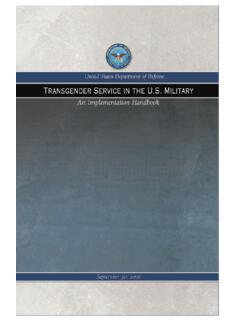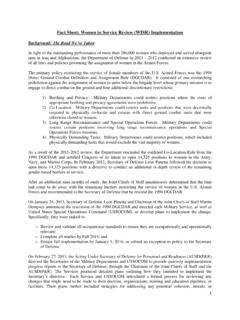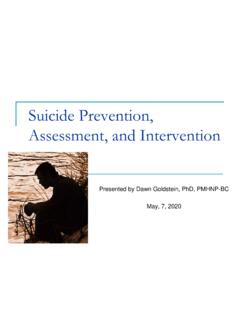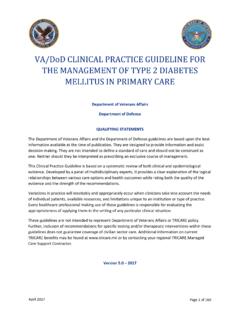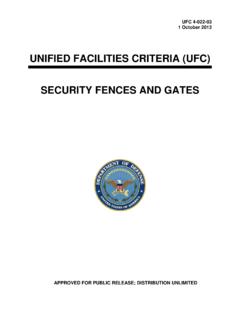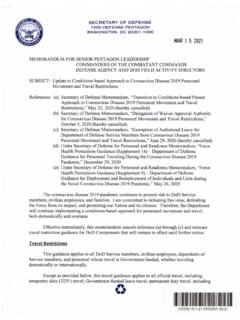Transcription of TRAC-F-TR-15-016 - U.S. Department of Defense
1 TRAC-F-TR-15-016 21 April 2015 Gender Integration Study TRADOC Analysis Center 255 Sedgwick Avenue Fort Leavenworth, KS 66027-2345 Distribution limited by Commanding General, TRADOC. This determination was made on 24 January 2013. Other requests for this document will be referred to Headquarters, Army TRADOC, Attention: G3/5, 950 Jefferson Avenue, Fort Eustis, VA 23604. TRAC-F- TR-15-016 21 April 2015 Gender Integration Study TRADOC Analysis Center 255 Sedgwick Avenue Fort Leavenworth, KS 66027-2345 Distribution limited by Commanding General, TRADOC. This determination was made on 24 January 2013. Other requests for this document will be referred to Headquarters, Army TRADOC, Attention: G3/5, 950 Jefferson Avenue, Fort Eustis, VA 23604. ii This page intentionally left blank. iii REPORT DOCUMENTATION PAGE Form Approved OMB No. 0704-0188 Public reporting burden for this collection of information is estimated to average 1 hour per response, including the time for reviewing instructions, searching existing data sources, gathering and maintaining the data needed, and completing and reviewing this collection of information Send comments regarding this burden estimate or any other aspect of this collection of information, including suggestions for reducing this burden to Department of Defense , Washington Headquarters Services, Directorate for Information Operations and Reports (0704-0188), 1215 Jefferson Davis Highway, Suite 1204, Arlington, VA 22202-4302 Respondents should be aware that notwithstanding any other provision of law, no person shall be subject to any penalty for failing to comply with a collection of information if it does not display a currently valid OMB control number PLEASE DO NOT RETURN YOUR FORM TO THE ABOVE ADDRESS 1.
2 REPORT DATE (DD-MM-YYYY) 21-04-2015 2. REPORT TYPE Technical Report 3. DATES COVERED (From - To) Jan 2013 Feb 2015 4. TITLE AND SUBTITLE Gender Integration Study 5a. CONTRACT NUMBER 5b. GRANT NUMBER 5c. PROGRAM ELEMENT NUMBER 6. AUTHOR(S) Arnhart, Lynette, COL Crosswhite, Blair Jebo, Jennifer Jessee, Michael, MAJ Johnson, Dominic Lechtenberg-Kasten, Sara Kerekanich, Peter McGrath, Amy Williams, Blair, LTC 5d. PROJECT NUMBER 030058 5e. TASK NUMBER 5f. WORK UNIT NUMBER 7. PERFORMING ORGANIZATION NAME(S) AND ADDRESS(ES) Army TRADOC Analysis Center (TRAC) ATTN: ATRC 255 Sedgwick Avenue Fort Leavenworth, KS 66027-2345 8. PERFORMING ORGANIZATION REPORT NUMBER TRAC-F-TR-15-016 9. SPONSORING / MONITORING AGENCY NAME(S) AND ADDRESS(ES) 10. SPONSOR/MONITOR S ACRONYM(S) Secretary of the Army 101 Army Pentagon Washington, DC 20310-0101 HQDA 11. SPONSOR/MONITOR S REPORT NUMBER(S) 12.
3 DISTRIBUTION / AVAILABILITY STATEMENT Distribution limited by Commanding General, TRADOC. This determination was made on 24 January 2013. Other requests for this document will be referred to Headquarters, Army TRADOC, Attention: G3/5, 950 Jefferson Avenue, Fort Eustis, VA 23604-5700. 13. SUPPLEMENTARY NOTES 14. ABSTRACT On 19 April 2013, Headquarters, Department of the Army (HQDA), issued strategic guidance for gender integration implementation planning. Designated Soldier2020, this initiative reflects the Army s effort to address policies on women in combat and to evaluate all positions in the Army to determine their requirements physical, mental, and emotional regardless of gender. The goal of Soldier2020 is to enhance force readiness and capability by applying a scientific approach for evaluating and validating military occupation specialty (MOS)- specific standards. This will aid leadership in selecting the best-qualified Soldiers regardless of gender for each position.
4 As part of Soldier2020, HQDA tasked TRAC to conduct the Gender Integration Study to identify the institutional and cultural factors associated with integrating women into previously closed MOSs and units and to recommend implementation strategies. Based on extensive research and data collection, this report identifies the factors expected to affect integration, presents the results of a risk assessment and mitigation effort, and provides near-, mid-, and long-term recommendations. This report recommends that the Army proceed with gender integration of all previously closed areas of concentration, MOSs, units, and positions. Analysis determined that the mitigated risk of the identified study factors to unit morale, cohesion, and readiness is moderate if the Army can appropriately address two high-risk factors: Soldier concerns about sexual harassment and sexual assault. Given these findings, the assignment of women to specific positions and occupational specialties does not conflict with the guiding principles outlined by the Chairman of the Joint Chiefs of Staff.
5 15. SUBJECT TERMS Soldier 2020, S2020, gender integration, women in the Army 16. SECURITY CLASSIFICATION OF: 17. LIMITATION OF ABSTRACT 18. NUMBER OF PAGES 19a. NAME OF RESPONSIBLE PERSON Mr. Peter Kerekanich a. REPORT U b. ABSTRACT U c. THIS PAGE U U 66 19b. TELEPHONE NUMBER (include area code) (913) 684 - 9316 Standard Form 298 (Rev. 8-98) Prescribed by ANSI Std Z39 18 iv This page intentionally left blank. FOR OFFICIAL USE ONLY / LIMITED DISTRIBUTION v Acknowledgments These organizations and individuals significantly contributed to this analysis: TRADOC Analysis Center TRADOC G3/5 Army Knowledge Online Army National Guard HQDA G-1 Army Armor School Army Cadet Command Army Civil Affairs & Psychological Operations Command (Airborne) Army Education Advisory Committee Army Engineer School Army Field Artillery School Army Forces Command FOR OFFICIAL USE ONLY / LIMITED DISTRIBUTION vi Army Human Research Protections Office Army Human Resources Command Army Infantry School Army Recruiting Command Army Research Institute Army Research Institute for Environmental Medicine Army Reserve Command Army Sergeants Major Acadamy Army Special Operations Command Army War College 1st Stryker Brigade Combat Team (BCT) / 1st Armored Division (AD)
6 2nd Armored BCT / 1st AD 2nd Armored BCT / 3rd Infantry Division 3rd Infantry BCT / 82nd Airborne Division 4th Infantry BCT / 10th Mountain Division 48th Infantry BCT, Georgia Army National Guard vii Table of Contents Acknowledgments .. v List of Figures .. viii List of Tables .. viii Executive Summary .. ES1 Chapter 1. Introduction and Overview .. 1 Background.. 1 Study Overview.. 1 Principal Finding and Recommendation.. 2 Report Organization.. 3 Chapter 2. Analytic Framework .. 5 Problem Statement.. 5 Study Purpose.. 5 Study Objective.. 5 Study Issues.. 5 Constraints, Limitations, and Assumptions.. 6 Study Methodology.. 8 Analytic Framework Conclusion.. 18 Chapter 3. Analytic Findings ..19 Introduction.. 19 Major Factors .. 20 Intermediate Factors .. 30 Minor Factors.. 41 Analytic Findings.. 44 Analytical Synopsis .. 48 Chapter 4. Summary and Conclusion ..49 Principal Finding and Recommendation.. 49 Summary of Results.
7 49 Conclusion.. 52 Glossary ..53 viii List of Figures Figure 1. Scheme of Analysis.. 8 Figure 2. Phase 2 Methodology.. 16 Figure 3. Phase 3 Overview.. 18 Figure 4. Overview Logic Map.. 44 List of Tables Table 1. Survey Overview .. 10 Table 2. Focus Group Overview .. 13 Table 3. Army Education Advisory Committee Members .. 14 Table 4. Army Senior Leader Engagements .. 15 Table 5. Study Factor Classification .. 20 ES1 Executive Summary As part of the Soldier2020 effort, Headquarters, Department of the Army (HQDA) tasked the Training and Doctrine Command (TRADOC) Analysis Center (TRAC) to conduct the Gender Integration Study (GIS). HQDA directed TRAC to identify the institutional and cultural factors associated with gender integration, and where possible, identify risk mitigation controls to enable the successful integration of women into previously closed combat arms military occupational specialties (MOSs) /units. This Report is the culmination of GIS and reflects two years of research and analysis to generate findings and recommendations.
8 Using multimethod research design, the TRAC study team identified institutional and cultural factors anticipated to affect gender integration. GIS identified these factors through four sources: 1) literature review of 200+ works; 2) eight surveys including Army women and combat arms Soldiers (over 60k participants); 3) 130 focus groups conducted across the Army; and 4) subject matter expert elicitation from numerous senior leaders and the Army Education Advisory Committee. Upon identification of 17 study factors, the GIS team solicited feedback from the Army Sergeants Major Academy to assess each factor s initial risk and residual risk with refined mitigation controls. This analysis leveraged nearly 400 senior non-commissioned officers (NCOs) who assessed the risk of integration to unit morale, cohesion, and readiness as moderate if the Army can appropriately address Soldier concerns about sexual harassment and assault. Next, the GIS team conducted site visits with four brigade combat teams (BCTs) and interviewed 35 command teams to assess the feasibility and acceptability of proposed controls.
9 These combined activities leveraged the experience of Army leaders to build the study s recommendations based on unit-level risk. Additionally, the study conducted 35 separate engagements with senior Army leaders (general officer/SES-level) to collect additional guidance and feedback. Based on study results, the Army should proceed with integrating women into previously closed combat arms MOS/units. To successfully integrate, the Army must address the following barriers: inconsistent enforcement of existing standards and perceptions of double standards; incidents of unprofessional behavior and indiscipline; fear of sexual harassment and assault; cultural stereotypes; and ignorance of current Army policy. The Army has experience navigating historic integration initiatives. Like previous efforts, the success of gender integration will take time and requires a focus on standards, policy, and leader development. The Army can reduce integration barriers in four broad ways.
10 First, Army leadership must effectively communicate the rationale and importance of integration to the force. Second, the Army must continue to develop, maintain, and enforce MOS-specific physical standards. Third, the Army must leverage on-going reviews to identify strategies to address the secondary effects of the Sexual Harassment / Assault Response and Prevention Program (SHARP) on future integration efforts. Fourth, the Army must resource a long-term leader development program focused on the Army Professional Ethic. In addition to these four actions, the Army should develop an enduring (and proactive) assessment plan to measure the effectiveness and progress of integration. ES2 This page intentionally left blank. 1 Chapter 1. Introduction and Overview Background. Effective 14 May 2012, the Secretary of the Army (SecArmy) rescinded the part of the 1994 Department of Defense (DOD) Direct Ground Combat Definition and Assignment Rule (DGCAR) that permitted the Army to bar assignment of women to units and positions doctrinally required to physically collocate and remain with direct ground combat units.

